
Education in the Knowledge Society 23 (2022)

Understanding Instructors’ Motivations to Improve MOOC Sustainability
Entendiendo las motivaciones de los profesores de los MOOC para mejorar su sostenibilidad
Ignacio Despujola*, Linda Castañedab, Carlos Turróc
a Área de sistemas de información y comunicaciones, Universitat Politècnica de València, Valencia, España.
https://orcid.org/0000-0003-2776-1638 ndespujol@asic.upv.es
b Departamento de Didáctica y Organización Escolar, Universidad de Murcia, Murcia, España.
https://orcid.org/0000-0002-1055-9241 lindacq@um.es
c Área de Sistemas de Información y Comunicaciones, Universitat Politècnica de València, Valencia, España.
https://orcid.org/0000-0002-3840-9405 turro@cc.upv.es
(*) Autor de correspondencia / Corresponding author
ABSTRACT
The global success of Massive Open Online Courses (MOOC) makes its analysis crucial to guarantee the quality, engagement, and best results in their implementation. Much research has been dedicated to understanding learner’s experience and institutional results, but few papers have studied the instructor’s perspective, which is essential to making MOOC a sustainable endeavor. This study has examined the perceived motivation for participating in a MOOC initiative and the impact on their career development for 79 teachers involved in a university experience that has made more than 600 editions of 115 MOOCs with 4 million enrolments. The study aims to confirm and expand previous studies’ findings and consolidate the institutional strategy regarding the resources and dynamics of MOOCs. Main research findings indicate intrinsic motivation factors are essential for MOOC instructors, and the lack of official recognition can be a relevant factor affecting MOOCs’ long-time sustainability.
Keywords
MOOC, online teaching, e-learning, institutional strategy
RESUMEN
El éxito global de los Cursos Online Masivos y Abiertos (MOOC) hace que su análisis sea crucial para garantizar la calidad, el compromiso y los mejores resultados en su implementación. Se han dedicado muchas investigaciones a entender la experiencia del alumno y los resultados institucionales, pero pocos trabajos han estudiado la perspectiva del instructor, que es esencial para hacer de los MOOC un esfuerzo sostenible. Este estudio ha examinado la motivación percibida para participar en una iniciativa MOOC y el impacto en el desarrollo de su carrera en 79 profesores involucrados en una experiencia universitaria que ha realizado más de 600 ediciones de 115 MOOC con 4 millones de inscritos. El estudio pretende confirmar y ampliar los hallazgos de estudios anteriores y consolidar la estrategia institucional en cuanto a recursos y dinámica de los MOOC. Los principales resultados de la investigación indican que los factores de motivación intrínseca son esenciales para los instructores de los MOOC y que la falta de reconocimiento oficial puede ser un factor relevante que afecta a la sostenibilidad de los MOOC a largo plazo.
Palabras clave
MOOC, educación en línea, e-learning, estrategia institucional
1. Introduction
Massive Open Online Courses (MOOC), that started with a connectivist based approach, now known as c-MOOC (Lugton, 2012), have reached millions of internet users since they were popularized in late 2011, when Stanford university launched courses with over 100 thousand enrolments each (Rodriguez, 2012) in a format based on video lessons, multiple-choice and numeric exams, and online forums, later called x-MOOC (Lugton, 2012). Although x-MOOC is the dominant format, these two initial formats have given way to a plethora of hybrid formats (Clark, 2013), with some of them (s-MOOC) encouraging the interaction in social networks as an integral tool of the learning process (Brouns et al., 2017), others (ah-MOOC) incorporating adaptative learning (García-Peñalvo, Fidalgo-Blanco, & Sein-Echaluce, 2018) and others (t-MOOC) fostering the collaborative creation of new courses by students as the learning tool (Osuna-Acedo, Marta-Lazo, & Frau-Meigs, 2018).
Eleven years after this first success, the MOOC movement has expanded every year, with over 19,400 courses from 950 universities worldwide enrolling over 220 million at the end of 2021 -excluding China MOOC providers- (Shah, 2021), and thousands of platforms offering MOOC ranging from global and country platforms to small niche ones (OpenedX, 2018, OpenedX, 2021).
MOOCs have been the subject of thousands of research papers focused mainly on learners, including their experiences, satisfaction, motivations, interaction patterns, and learning outcomes. There are over 15 literature reviews on the subject (Despujol et al., 2022), ranging from 2013, e.g., (Liyanagunawardena, Adams, & Williams, 2013) to more recent times, e.g., (Babori, 2020; Rasheed et al., 2019). However, many questions are still to be answered (Margaryan, Bianco, & Littlejohn, 2015; Rolfe, 2015; Toven-Lindsey, Rhoads, & Lozano, 2015, Babori, 2020). MOOCs are still struggling with sustainability (Conole, 2014; Shah, 2016; Schuwer et al., 2015) and low completion rates (Khalil & Ebner, 2014), and there are critical visions about their role in the Higher Education (HE) ecosystem (Bulfin, Pangrazio, & Selwyn, 2014) and the pedagogical implications of their “massive” teaching models (Bartolomé-Pina & Steffens, 2015). A small percentage of all this research has focused on MOOC instructors (Blackmon, 2018; Roth, 2013; Kolowich, 2013; Zheng et al., 2016; Blackmon, 2018; Gonçalves & Gonçalves 2019) and a small fraction on how MOOC development impacts MOOC instructors on their motivation and career development (Kolowich, 2013; Lowenthal et al., 2018; Young-Doo et al., 2020).
Considerable time and effort are required to design and develop MOOC (Zhu, Bonk, & Sari, 2018), and the courses are offered for free or for a minimal fee, so understanding the motivations and frustrations of instructors developing MOOC is important for the long-term sustainability of the initiative.
Several previous studies highlight that MOOC instructors are primarily driven by intrinsic rather than extrinsic incentives (Lowenthal et al., 2018; Najafi et al., 2015). These motivations include an instructor's passion for teaching their subject of expertise, a desire to foster innovations in teaching and learning, and the belief that MOOCs are a good tool to promote educational equality (Hew & Cheung, 2014; Lowenthal et al., 2018). Extrinsic incentives include the opportunity to increase publicity and influence (Kolowich, 2013; Lowenthal et al., 2018) and promote (Hew & Cheung, 2014). All these studies conclude that instructors think teaching MOOCs is worth it.
Nevertheless, studies also indicate that instructors often lack adequate professional preparation in online teaching (Zhu et al., 2018). Number of enrolments, different expectations, personal circumstances of learners (some who do not intend to finish the courses) (Hew & Cheung, 2014), distance, and the use of a technological platform make them a very different knowledge construction and transmission environment from traditional classrooms (Ross et al., 2014).
This study extends the research made by Young-Doo et al. (2020), which, in a non-randomized sample of instructors (149) from the English-speaking global community, explored what benefits they perceive and the problems that frustrate them when they develop a MOOC. This paper incorporates the views of the entire community of instructors of Universitat Politècnica de València (UPV) –with a representative sample (88.88% of the total population)– that created MOOC in Spanish. This study explores their motivations and examines the knowledge and skill areas they think need to be reinforced for teaching MOOC more effectively in their institution and localizing these results in a precise context that makes their conclusions concrete contributions to institutional development that can be transferred to other contexts.
As UPV, many universities are integrating the MOOC as a part of their approach to digital education, so understanding the motivation of one of the key actors is crucial for them.
Our ambition is to continue creating an ecological perspective of the institutional strategic digital education development of MOOC after the analysis of the management of the initiative (Despujol et al., 2018), the curriculum development (Despujol et al., 2022), and their influence on other levels of education (Llorente-Ruiz, Despujol, & Castañeda, 2021).
2. Materials and methods
The study’s primary goal is to get an insight into the motivations and concerns of the MOOC instructors/developers from an HE institution’s community – in this case, the one configured by the Universitat Politècnica de València (UPV)–, analyzing their motivations and how the initiative impacts their career development, and how this is related to the institutional strategic digital education development.
This study formulates the following research questions:
•RQ1: What motivates UPV instructors to teach MOOCs and what support have they received from the institution?
•RQ2: What outcomes have UPV instructors gotten from teaching MOOCs?
•RQ3: How do MOOC instructors get their training to create and deploy MOOCs?
•RQ4: What aspects of the MOOC process do UPV instructors think can be improved and how?
•RQ5: Are instructors satisfied with their MOOC experience?
The exploration has been structured as a case study, as it is a research approach to generate an in-depth, multi-faceted understanding of a complex issue in its real-life context (Crowe et al., 2011). This study case is considered evaluative but with a descriptive approach (Cohen, Manion, & Morrison, 2017). To get insight into instructor motivations, this study administered an online survey, developed, and validated in Young-Doo et al. (2020), with open response fields that let instructors extend their contributions if they wanted.
With a principal quantitative focus but a qualitative complement, this mixed-method approach has enabled the researchers to approach the research questions quantitatively and qualitatively (Creswell & Creswell, 2018). Quantitative data has been analyzed from a statistical approach. Qualitative data (responses to the open-ended survey questions) were analyzed using a double cycle of coding, a first exploratory cycle using a structural initial coding method, followed by a pattern coding to remark the categories that emerge, and a second cycle of content-attribution coding, where the answers on each pattern were attribute coded, identifying internal patterns or classifying them as positive, neutral, or negative (Saldaña,2015). Two researchers performed the coding; each completed one cycle of coding.
2.1. Survey
The survey was adapted from the survey created and validated by Young-Doo et al. (2020) and collected instructors' perceptions of their motivation to develop MOOC and how this work contributes to their career development. The survey has been modified to localize its results, adapting its content to UPV’s reality. The modifications were: (1) questions about the number of MOOCs taught, their types (instructor-led or self-paced), and the number of enrolments retired because the research team had access to the official institutional information from the platform; (2) a section to evaluate the experience was added; (3) a scale from 0 to 5 to evaluate the relative importance of each item was included in some questions asked; (4) one question was retired because it was considered redundant in the context of UPV; (5) questions were reorganized in more sections for clarity.
The survey consisted of 19 questions organized into five sections:(a) demographic information and online teaching experience (four questions); (b) motivation for teaching MOOC (two questions); (c) career outcomes and impact on teaching (three questions), (d) MOOC Training (5 questions) (e) evaluation of the experience (5 questions) (See Appendix I).
The survey included the collection of:
•Demographic information (age, gender, job, and previous experience with online teaching)
•Motivation for teaching
○Types of support provided
○Different motivational factors and their importance, with a scale from 0 to 5 for rating the relevance of each item
•Career outcomes and impact on teaching
○Different career outcomes obtained, with a scale from 0 to 5
○Has MOOC teaching affected your pedagogy? Yes/No
○Have you changed the way you teach other courses? Yes/No
•MOOC training
○Have you helped other teachers to start with MOOCs? Yes/No
○Different ways you have helped other teachers, with a scale from 0 to 5 for rating the relevance of each item
○How many hours of training have you received?
○Different ways you have received training, with a scale from 0 to 5 for rating relevance of each item
○Which skills would you like to gain to improve your MOOC teaching?
•Efforts devoted and evaluation of the experience
○Is it worth teaching a MOOC? (Yes/No)
○Have the monetary incentives given by the university influenced your decision to create the MOOC? (Yes/No)
○Have the support mechanisms offered by the university influenced your decision to create the MOOC? (Yes/No)
○What would you improve in the support offered by the university? (Open-ended)
○Any other comments you want to add? (Open-ended)
The final version of the survey has been validated following the original method of validation. Therefore, the structure and content of the survey were validated using a content and face validation (Holden, 2010) process that guarantee the appropriateness and relevance of the items as they appear to the persons answering the survey (Connell et al., 2018).
2.2. Study Context
UPV is a mid-sized public Spanish university (UPV, 2021a) that is the leader of the Spanish-speaking MOOC offer, with over 100 courses and 3.5 million enrolments on edX at the moment of writing this paper (edX, 2022). UPV launched its own MOOC initiative in 2013 and, since then, has been using MOOC as one of its strategic levers for digital transformation (Despujol et al., 2018). UPV started with its own MOOC platform (upvx.es, which is still in use today), participated in miriadaX.net (a Spanish speaking MOOC platform), and joined the edX.org at the end of 2014, launching over 600 editions of 115 MOOCs –most of them in Spanish– with almost 4 million enrolments (Despujol et al., 2022).
UPV is open to any of its faculty or staff proposing the creation of a MOOC. A commission approves the new MOOC proposals, and once they are approved, the instructors are directed to the MOOC department. There is a yearly program to incentivize the creation of digital learning materials that gives faculty a little money and academic points if they present their MOOC (UPV, 2021b). The program also provides academic points for MOOC supervision each time a new run is launched.
In a few cases, the university gave course release time for the MOOC creation to the instructors that created university entry-level MOOC for new university students (Llorente-Ruiz et al., 2021), and in others, instructors got financing from edx.org for preparing specific MOOC demanded by institutional customers. Nevertheless, most developers create their MOOCs without knowing if they will get any income from them (the University splits the revenue from edx.org via the certificate fees, and a few UPV MOOCs have been successful in revenue generation, but most are not producing earnings for the instructors).
UPV has a specific department to help instructors develop and run MOOCs, with a set of processes that lets them choose between focusing only on content design and development and participating in the design of the courses as much as they want (Despujol et al., 2018; Turro et al., 2010).
The MOOC team has created a SPOC (Small Private Online Course) to train MOOC instructors that is always open as a self-paced course (https://bit.ly/3Fx6wtp), and two synchronous runs are launched per year. A pdf guide for MOOC instructors has also been created.
UPV has a common team of teaching assistants that attends the forums of all running courses, scanning the questions and sending them to MOOC instructors only when necessary, so all instructors can rely on them when managing the forum of their MOOC.
2.3. Participants
A Web-based survey was sent by email to the 89 main instructors of UPV’s MOOCs (there are over 100 courses, but some instructors teach in more than one MOOC), and 79 (88.8%) completed the survey. Even if this is a self-selected sample, its big size regarding the population should correct the selection bias and reinforce the results and conclusions, making them even more important to be considered for the entire institution (Hirschauer et al., 2021).
In terms of the gender of the participants, 50 identify themselves as male (63.3%) and as 29 female (36.7%). Their ages varied between 25 and 79 years old, with an average 51.5 years.
Most instructors in the sample work for UPV either as faculty, researchers, or technical staff (Figure 1). 83% were faculty, with most being full professors (33%), called Catedráticos, or associate professors (33%), called Titulares de Universidad, 6% were technical staff (identified in figure 2 as PAS) and 4% were researchers (identified in figure 2 as Investigador). There was a retired faculty (identified in figure 2 as Profesor jubilado), 2 emeritus professors, and 5% were external collaborators. The rest of faculty positions (Profesor contratado doctor, Profesor ayudante doctor, Profesor colaborador, Catedrático de escuela universitaria and Profesor Asociado) are difficult to translate to other university systems outside of Spain.
Figure 1. Position of MOOC instructors.
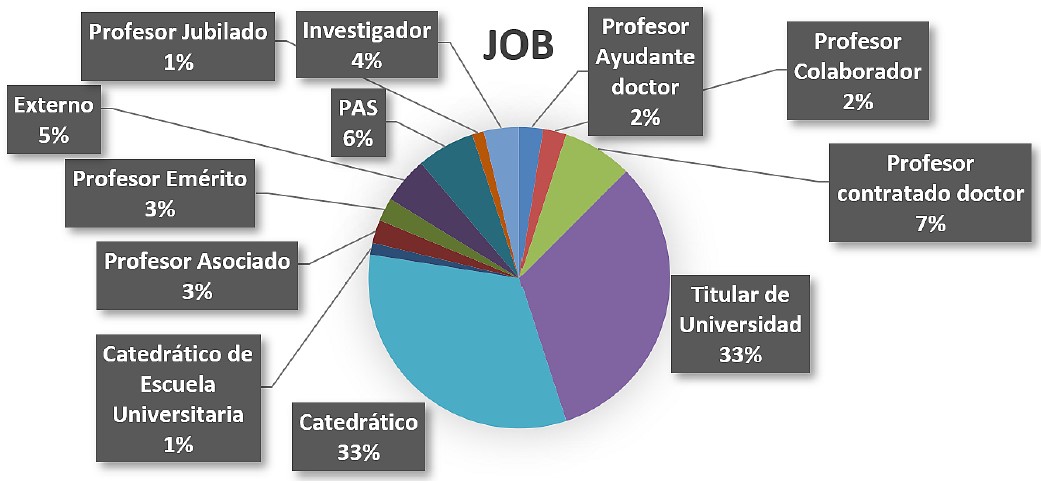
Figure 2. Online or blended courses taught before.
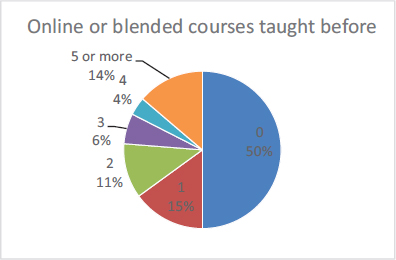
Half of the sample had never participated in an online or blended course, and 5% had participated in 5 or more (Figure 2).
As for the number of MOOCs developed, most participants had developed one (36%) or two (32%) MOOCs, with 11% having developed 5 or more MOOCs (Figure 3).
Figure 3. Number of MOOC taught.
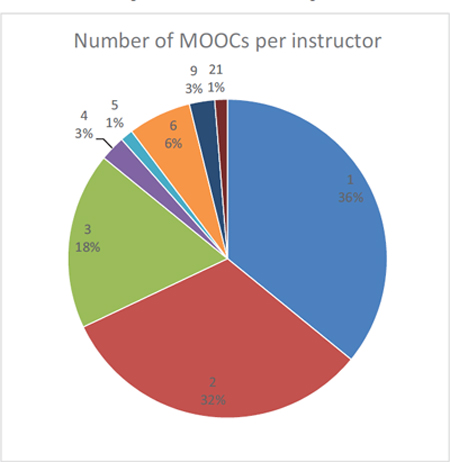
Most MOOCs had been run several times (the average number of runs per course was 5, with a maximum of 15 runs and a minimum of 1), usually starting with an instructor-led run and following with self-paced runs, so all instructors had experience with both types of MOOC delivery.
The instructor participating in this study had created 122 MOOCs, of which 616 runs had been delivered since January 2013. The average enrolment in a MOOC run was around 7,000, with a maximum of 160,000 enrolments and a few runs of some MOOC with a few tens.
3. Results
This section has organized data and results using the Research Questions order.
RQ 1: What motivates UPV instructors to teach MOOCs, and what support have they received from the institution?
Two questions support the answer to this research question (section a). The first one aimed to know the types of support that instructors perceive they have gotten from the university. As it is clear in Figure 4, more than half the instructors mention technical support (55% of respondents), with additional compensation and colleague support in a second tier (identified by 40% of people), and training and productivity or service recognition in a third (32.5%). Support by the administration (chosen by 15% of instructors), discretionary funding (12.5%), and course release time (selected by 11.25%) were the less mentioned types (Figure 4).
Figure 4. Support received by instructors.
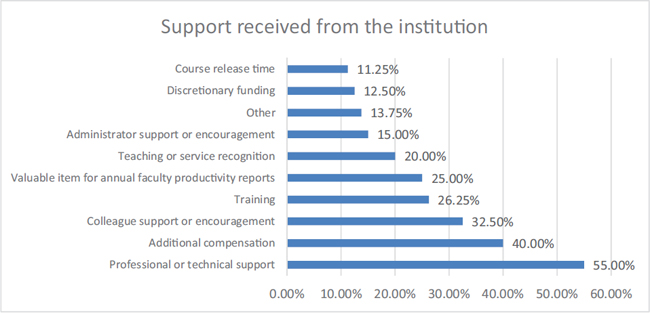
In the next question (Figure 5), instructors were asked to grade different motivation factors from 0 to 5; “Opportunity to reach more people” was graded with 4.3, “Wanting to share knowledge” with 4.0, and “Commitment to open education” with 3.9. “Learning new methods and pedagogies” and “Personal challenges” also ranked high. “Personal branding and reputation” with 3.0 and “Department or institution branding” and “Career development” with 2.7 ranked in the middle of the table. Factors related to incentives as money or course release time ranked low.
Figure 5. Motivational factors.
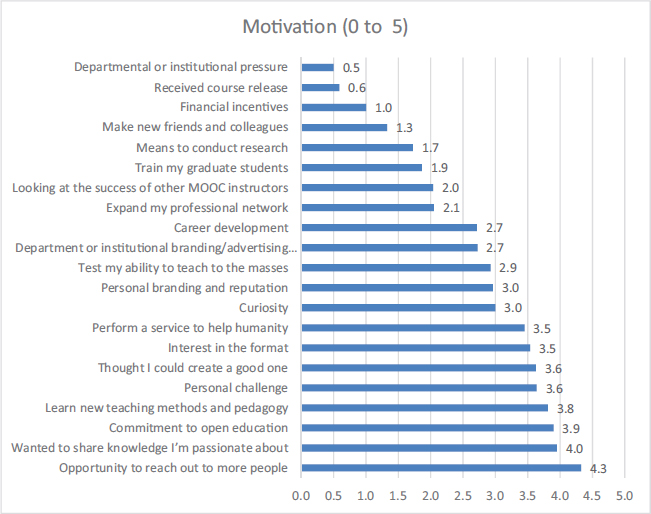
RQ 2: What outcomes have instructors gotten from teaching MOOCs?
Three questions (survey section b) are aimed to answer this research question, one devoted to career outcomes and the other two dedicated to asking about the impact of teaching MOOC on the instructor’s teaching style.
The answers to the first question of the section (Figure 6) show that instructors consider the most important outcomes obtained to be related to learning new pedagogies (with an average of 3.4/5), increasing their social and international awareness (3.2/5), improving their teaching skills (3.1/5), boosting their commitment with the international service (2.8/5), and enhancing their reputation (2.7/5). The instructors don’t seem interested in using MOOC data for research (1.3/5) or departmental/institutional respect (1.7/5).
Figure 6. Career outcomes.

Answers to the second and third questions of this section, included in Figure 7 and Figure 8, reveal that MOOCs have had an important impact on the teaching style of the instructors (65% answered yes to the question “has MOOC teaching affected your pedagogy?”), and 62.5% believe they have changed the way they teach other courses.
Figure 7. Impact on teaching style.
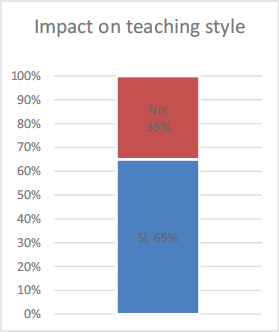
Figure 8. Impact on other courses.
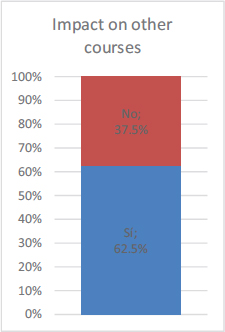
RQ3: How do MOOC instructors get their training to create and deploy MOOCs?
More than half the instructors that answered the survey (42 of 79, 53.2%) declared they had received no formal training on MOOC development. Among the other 38 instructors that participated in the survey (Figure 9), the formal training average time is 8 hours. Three instructors had received a big amount of training in the field (150, 60 and 40 hours), 13 instructors declared they had received 10 hours, 6 declared 20 hours and 5 answered 5 hours of training.
Figure 9. Hours of training received.
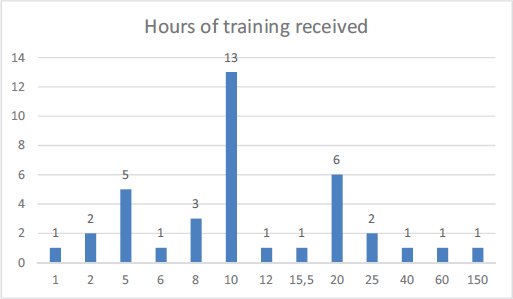
As in Figure 10, when instructors are asked about the usefulness of the resources they have used to learn about MOOC teaching, it is essential to remark there are no resources scored with an average higher than 2.5 (from 5 possible), and two of the resources scored beyond 2 points on average. The most valued resources are browsing or attending other MOOCs (that scored 2.5 on average) and receiving training about the MOOC platform (that scored 2.1 on average).
Figure 10. Usefulness of training received.
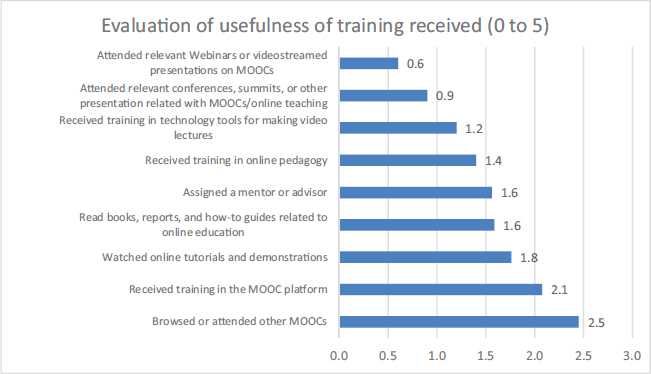
According to data in Figure 11, a little more than half of the MOOC instructors surveyed (52.5%) have used their MOOC as an example for other colleagues, 37.5% have presented their experiences related to MOOC in events, and 33.75% provided an informal demonstration or presentation related to their experience.
Figure 11. Support to other colleagues.
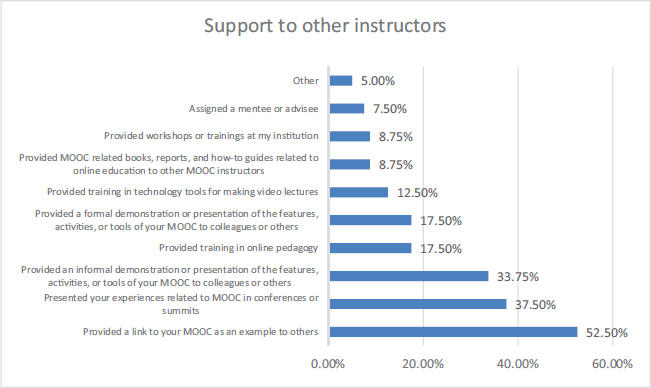
To explore the skills that instructors considered important to improve their MOOC developing skills, the study included the open-ended question “Which skills would you like to gain to improve your MOOC teaching?” 34 instructors (43.03% of the entire sample) answered it. Three main themes surfaced in the coding phase: technical skills (mentioned 20 times by 25.31% of instructors), online pedagogy (mentioned 10 times in 12.65% of the answers), and presentation skills (mentioned 4 times, by 5.06% of instructors). Two answers mentioned languages capabilities, another mentioned learning about student feedback, two mentioned that they needed no extra training, two made improvement proposals to the platform, and two contained positive feedback for the MOOC team.
Delving into the technical capabilities demands, the most demanded technical skill included in the answers was the one related to generating videos (6 mentions), “video editing in order to make them more flexible in terms of format and to integrate other types of material” (participant 14). The second most mentioned was new technologies abilities (4 mentions), and 3D/simulation software – “Ability to create interactive simulations, such as virtual laboratories, with significant graphic support to facilitate the acquisition of skills by students” (participant 24)– and presentation tools (with 3 mentions each). Two answers mentioned learning more about the course statistics tool, and one mentioned learning about course development in the MOOC platform.
The training demands related to pedagogy mentioned training in MOOC learning strategies and online learning strategies (with 3 mentions each) – “…how to reach learners online, online teaching practice” (participant 18) , personalization of the learning experience, “Strategies for designing pedagogically appropriate content for different learner segments” (participant 32)–, new evaluation methods and forum dynamization (with one mention each), and the gathering of good practices (with one mention).
The four answers that mentioned presentation skills were related to improving speaking capabilities – “diction” (participant 20), “the way of expressing” (participant 31)– (3 mentions), or video presentation skills (1 mention).
RQ4: What aspects of the MOOC process do UPV instructors think can be improved and how?
46 instructors answered the open-ended question, “What would you improve in the support offered by the university?” 23 of the instructors answered with positive comments about the support received; 19 did not add any other suggestion – “I can't think of anything, because it is a magnificent support” (participant 8).
We also gathered 8 improvement suggestions from the other open-ended question in the survey (that asked about any other comment they wanted to make and was not included in the rest of the questions) and incorporated them into this question.
Most answers are related to the lack of formal recognition by the university of the work done, with 8 answers asking for course release time, 3 answers asking for more points for annual faculty productivity reports, and 2 answers demanding more recognition from the administration. We can see instructors think more resources should be dedicated to recognizing their dedication to MOOC preparation and running – “I think that the UPV does not correctly value the performance of MOOCs in aspects such as IAD and POD. In the end all MOOCs are treated in a similar way, regardless of the results (enrolment, certifications, UPV image…). In my opinion, this is a mistake” (participant 18).
Six answers ask for support in development of course materials (4 for video edition and recording, one for other video formats, one for generic support) – “More post-recording editing to improve the final result” (participant 18) – 5 answers ask for more resources – “Create a stable advisory and support service” (participant 35)– and 3 for more course promotion – “Improve the dissemination of existing courses” (participant 4). Two answers ask for a periodic report from the MOOC team, one asks for a more profound revision and support of senior instructor designers when starting the first MOOC, one for more training, and another for more financial support. One answer asks for a change in the mechanism of reinforcement questions and another for creating MOOC templates.
RQ5: Are instructors satisfied with their MOOC experience?
The survey contained one question that directly asked if it was worth teaching a MOOC. The answer is unanimous among instructors; all 79 instructors think it was worth having created their MOOC.
The other two questions (Figures 12 and 13) were devoted to discovering if the small monetary incentive given by the university had motivated them to make the MOOC and if the support offered by the university had helped them to decide about making the MOOC. The answers are clear, the monetary incentive did not influence the decision to make the MOOC in 76% of cases but having strong support to develop the MOOC was a very important factor to make the decision (88.75% of the sample answered yes).
Figure 12. Importance of monetary incentives.
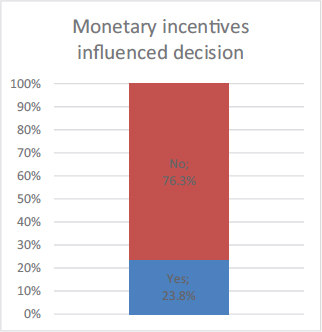
Figure 13. Importance of technical support.
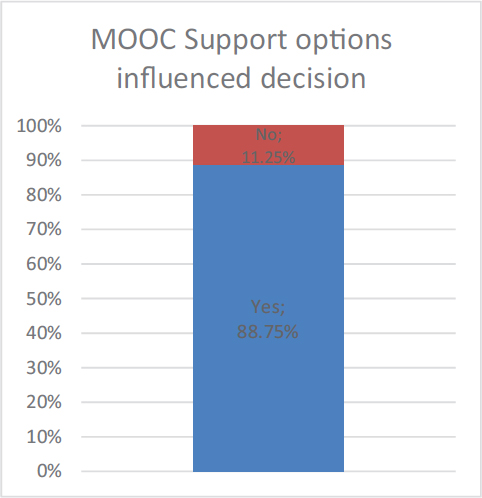
26 instructors answered the open-ended question, “Any other comments you want to add”. Nine used it to ask for improvements (2 reinforcing what they answered in the former question and 8 with new demands incorporated in the previous RQ), 9 were used to make positive comments about the support provided, and 5 were used to make suggestions (about extending the use of MOOCs to all basic training and courses, linking MOOCs with continuing education, compiling success cases, giving extended support to the instructors starting their first MOOC, and incorporating YouTube formats).
In the other answers, one commented on her main motivational factor, another commented on the enlargement of his professional network as an outcome of making the MOOC, and another commented the role of MOOCs as a tool to transform teaching.
4. Discussion
This paper explores and analyses the MOOC instructor’s motivations, satisfaction, and concerns of a big MOOC initiative from a technological Higher Education Institution in Spain. It is a significant MOOC initiative with more than a hundred courses with almost 4 million enrolments that has been running since 2013, and it compares the findings with the ones made by a more global study (Young-Doo et al., 2020) that reports general findings. The insights gathered will be useful for MOOC administrators and instructors, pointing to areas where improvements can be made.
This study has at least two evident limitations that have been commented along the paper. First, this research is a case study, so its conclusions can only be applied to the community of UPV MOOC instructors. Second, the survey used in this research was developed for practical purposes, so it lacks psychometric properties needed to apply certain methodologies. In addition, a more profound qualitative exploration is needed to explore other emergent possibilities, which is limited by using a questionnaire.
Focusing on the findings regarding the support received by instructors from the university, this study finds that instructors perceived that UPV had provided less technical support than the global instructors analyzed in the Young-Doo et al. (2020) study reported (55% versus 63.38%) and less administrative encouragement (15% versus 55.63%). Nevertheless, they perceived to have more additional compensation (40% against 24.65%). Other compensations are similarly mentioned. The big difference is that UPV’s instructors reported having received training twice the figure reported in the global study (26,25% versus 13.38%), a figure that is still low but significatively higher.
The conclusions in this area, reinforced by the answers to one of the open-ended questions of the survey (What would you improve in the support offered by the university?), are the same; more official recognition from the institutions is needed to keep most instructors motivated. They also coincide with problems reported by Zheng et al. (2016) in a similar study of MOOC instructor opinions, in which 93% of instructors mentioned lack of institutional support (resources or policy support). This is a hygiene factor as mentioned in Herzberg’s ‘Two-Factor Theory’ (Herzberg, 2003), as official recognition of the work of MOOC instructors probably will not motivate them, yet it might encourage them to quit if not properly addressed.
As seen in the question about motivation, the motivations of MOOC instructors are highly intrinsic, with reaching more people, sharing knowledge, commitment to open education, learning new pedagogies, or personal challenge as the top motivating factors. These findings are aligned with the findings of the study by Young-Doo et al. (2020) that groups motivation factors in 7 categories and points the 4 categories related to intrinsic factors as the most important being the three extrinsic categories: financial incentives and course release, research purpose, and institutional goals. Zheng et al. (2016) identifies four broad types of motivations that influence instructors to teach MOOCs, listed in order of importance: global impact on students, professional growth, research opportunities, and enhanced name recognition, which is in line with the findings of this study.
These findings are optimistic, as intrinsic motivation can positively influence individuals’ behaviors and attitudes toward jobs and job satisfaction (Herzberg, 2003), but institutions should not forget that instructors feel there is insufficient official recognition for the workload that a MOOC conveys, and that is a strong extrinsic factor, that, if not properly addressed, can make instructors lose their interest in MOOC (as some of the open-ended answers indicated).
Personal and institutional branding and reputation are also ranked high as motivational factors by the instructors that perceive MOOC as a good tool to showcase the quality of their work. This is also mentioned in the study by Young-Doo et al. (2020).
The motivational factors are not exclusive, so institutions should deploy strategies to boost as many of them as possible, setting objectives that consider its institutional strengths and weaknesses related to MOOC.
The most important career outcomes mentioned by instructors were related to the improvement of their teaching, with the social and international commitment and professional reputation enhancement also ranking high.
The two questions about the impact of MOOC teaching in the teaching style and other courses taught by instructors remark on the use of MOOC as a tool to help instructors integrate the online paradigm in all their teaching activities.
Providing training in new technologies and pedagogies for the new online environment to their instructors is key for HE institutions to succeed in the not-so-distant future. The answers to the questions about which training instructors had received, with a little more than half of them stating they have received no formal training, are a little discouraging, considering that UPV has made a big effort to provide training opportunities to teachers (including a SPOC permanently open in the platform). One plausible explanation is that all instructors that have created MOOCs in the eight-year period from 2013 to 2021 have been surveyed, so the first instructors didn’t have the training courses available when they created their MOOC. Nonetheless, these data are distant from the ones found in Young-Doo et al. (2020), where fewer than 14% of the instructors declared having received formal training. This difference remarks that the training effort made by UPV has succeeded to some extent, but actions should be taken so all new instructors are trained before they start the MOOC creation process.
Teacher networks are a powerful resource, and the confirmation that half of the UPV’s MOOC instructors have supported other teachers in their onboarding to MOOCs is an important indicator for institutions that should foster this type of networking by giving instructors the tools and opportunities to collaborate. This is also highlighted in Young-Doo et al. (2020) findings.
When asked about which skills they would like to gain, most of the instructors mentioned technical skills in content production, online pedagogy, and presentation skills, which is in line with findings by Young-Doo et al. (2020).
To the question about what can be improved and how, most instructors gave positive feedback about the support process during MOOC creation and delivery. This is probably why no instructor mentioned the problems with scaling, dealing with massive unknowns, or reputation crisis mentioned by Zheng et al. (2016).
The bigger number of demands was related to the lack of official recognition (even as the UPV gives points for annual faculty productivity reports, they are a small recognition for the effort needed), with giving course release time being the most demanded item. A second group of demands was related to having more resources to develop MOOCs, either to develop course materials, to have more support from the team, or to promote the courses. These two demands coincide with previous research regarding HE institutions’ development of digital implementations (Castañeda, Esteve-Mon, & Postigo_Fuentes, 2022).
The final questions were devoted to ask about the instructor’s satisfaction with having created a MOOC, and the answer was unanimous. All instructors think the experience has been worth it. The small monetary incentive given by the university had much less influence on the decision of making a MOOC than having a strong and proactive support infrastructure to help them.
This paper has confirmed and extended the findings of the two most comprehensive studies to date about MOOC instructor motivations and concerns (Young-Doo et al., 2020; Zheng et al., 2016), but with an institutional perspective, surveying the MOOC instructors of UPV.
79 instructors answered a survey, and they all think creating the MOOC has been worth it, with having a strong and proactive support structure being one factor that influenced their decision about creating a MOOC. Their main motivators are intrinsic factors (reaching more people, sharing knowledge, commitment to open education, learning new pedagogies, or personal challenge), but instructors complain about the lack of recognition of their hard work. This can be a problem if the university doesn’t increase the funding of the initiative to recognize the effort made by teachers. Taking these factors into account is key for long-term MOOC sustainability.
Many instructors created their MOOCs without formal training, which is important if the university wants to transition to online and hybrid learning. This is probably because MOOCs are a new trend, and no training materials were available initially. The university has created the training resources and encourages all new MOOC instructors to use them.
The most crucial career outcomes mentioned by instructors were related to improving their teaching, with social and international commitment and professional reputation enhancement also ranking high. MOOCs had a substantial impact on the teaching style of most MOOC instructors.
Most instructors want to improve their technical skills in content production, online pedagogy, and presentation.
All these findings remarked the importance of the strategic approach of the UPV in their MOOC initiative as a crucial factor of success, not just to increase the opportunities for expansion and international recognition, but to reinforce the positive internal perception of the initiative and the engagement of some of the most important part the workforce implicated in it (Castañeda, et al., 2022; Illanes et al., 2018; Papadimitriou, 2020).
Declaration of interest
The authors declare that they have no competing interests.
Availability of data and materials
The data presented in this study are available on request from the corresponding author. The data are not publicly available due to privacy regulations.
Funding
This projects partially supported this research: “Competencies for Universities - using Technology in Education” CUTE, an ERASMUS+ Strategic Partnership (KA203-867FE04B), funded by the European Union.
References
Babori, A. (2020). Trends in MOOCs Research: Analysis of Educational Technology Journals. International Journal of Emerging Technologies in Learning (iJET). 15(17). 47–68. https://doi.org/10.3991/ijet.v15i17.14637
Bartolomé-Pina, A. R., & Steffens, K. (2015). Are MOOCs promising learning environments? Comunicar, 22(44), 91–99. https://doi.org/10.3916/C44-2015-10
Blackmon, S. (2018). MOOC makers: Professors’ experiences with developing and delivering MOOCs. International Review of Research in Open and Distributed Learning, 19(4), 76–91. https://doi.org/10.19173/irrodl.v19i4.3718
Brouns, F., Teixeira, A., Morgado, L., Fano, S., Fueyo, A., & Jansen, D. (2017). Designing Massive Open Online Learning Processes: The sMOOC Pedagogical Framework. In: M. Jemni, Kinshuk, & M. Khribi (Eds.) Open Education: from OERs to MOOCs (pp 315–336). Springer. https://doi.org/10.1007/978-3-662-52925-6_16
Bulfin, S., Pangrazio, L., & Selwyn, N. (2014). Making MOOC: The construction of a new digital higher education within news media discourse. The International Review of Research in Open and Distributed Learning, 15(5), 290–305. https://doi.org/10.19173/irrodl.v15i5.1856
Castañeda, L., Esteve-Mon, F., & Postigo_Fuentes, A. (2022). Digital teaching competence development in higher education: Key elements for an institutional strategic approach. In R. Sharpe, S. Bennett, & T. Varga-Atkins (Eds.), Handbook for Digital Higher Education. Edward Elgar Publishing Ltd.
Clark, D. (2013). MOOCs: taxonomy of 8 types of MOOC. Donald Clark Plan B, April 16, 2013. Retrieved from https://bit.ly/3Fz9Hkf. May, 23rd 2022
Cohen, L., Manion, L., & Morrison, K. (2017). Research Methods in Education. 8th Edition.
Connell, J., Carlton, J., Grundy, A., Taylor Buck, E., Keetharuth, A. D., Ricketts, T., Barkham, M., Robotham, D., Rose, D., & Brazier, J. (2018). The importance of content and face validity in instrument development: Lessons learnt from service users when developing the Recovering Quality of Life measure (ReQoL. Quality of Life Research, 27(7), 1893–1902. https://doi.org/10.1007/s11136-018-1847-y
Conole, G. (2014). A new classification schema for MOOC. The International Journal for Innovation and Quality in Learning, 2(3), 65–77. https://goo.gl/bL4GwN
Creswell, J. W., & Creswell, J. D. (2018). Research Design: Qualitative, Quantitative, and Mixed Methods Approaches. SAGE Publications, Inc.
Crowe, S., Cresswell, K., Robertson, A., Huby, G., Avery, A., & Sheikh, A. (2011). The case study approach. BMC Medical Research Methodology, 11(1), 100. https://doi.org/10.1186/1471-2288-11-100
Despujol, I., Castañeda, L., & Turro, C. (2018). Developing A MOOC Initiative: Lessons Learned from the Universitat Politècnica de València Experience. Turkish Online Journal of Distance Education, 19(1), 215–233. https://doi.org/10.17718/tojde.382805
Despujol, I., Castañeda, L., & Turró, C. (2022). What Does the Data Say about Effective University Online Internships? The Universitat Politecnica de Valencia Experience Using MOOC during COVID-19 Lockdown. Sustainability, 14(1), 520. https://doi.org/10.3390/su14010520
edX (2022). https://www.edx.org/es/search?tab=course
García-Peñalvo, F. J., Fidalgo-Blanco, Á., & Sein-Echaluce, M. L. (2018). An adaptive hybrid MOOC model: Disrupting the MOOC concept in higher education. Telematics and Informatics, 35, 1018–1030. https://doi.org/10.1016/j.tele.2017.09.012
Gonçalves, B. M. F., & Goncalves, V. B. (2019). Professional Development in MOOC: Teachers Motivation. In 2019 14th Iberian Conference on Information Systems and Technologies (CISTI). IEEE. https://doi.org/10.23919/CISTI.2019.8760597
Herzberg, F. (2003). One more time: How do you motivate employees? Harvard Business Review, January 2003. https://bit.ly/3WdQPNI
Hew, K. F., & Cheung, W. S. (2014). Students’ and instructors’ use of massive open online courses (MOOCs): Motivations and challenges. Educational Research Review, 12, 45–58. https://doi.org/10.1016/j.edurev.2014.05.001
Hirschauer, N., Grüner, S., Mußhoff, O., Becker, C., & Jantsch, A. (2021). Inference using non-random samples? Stop right there! Significance, 18(5), 20–24. https://doi.org/10.1111/1740-9713.01568
Holden, R. R. (2010). Face Validity. In The Corsini Encyclopedia of Psychology (pp. 1–2). https://doi.org/10.1002/9780470479216.corpsy0341
Illanes, P., Lund, S., Mourshed, M., Rutherford, S., & Tyreman. (2018). Retraining and reskilling workers in the age of automation. McKinsey Global institute. https://mck.co/3NtnACO
Khalil, H., & Ebner, M. (2014). MOOC completion rates and possible methods to improve retention a literature review. World Conference on Educational Multimedia, Hypermedia and Telecommunications, 1, 1305–1313.
Kolowich, S. (2013). The professors who make the MOOCs. Chronicle of Higher Education, 59(28), A20– A23.
Liyanagunawardena, T. R., Adams, A. A., & Williams, S. A. (2013). MOOC: A systematic study of the published literature 2008–2012. The International Review of Research in Open and Distributed Learning, 4(3), 202–227. https://doi.org/10.19173/irrodl.v14i3.1455
Llorente-Ruiz, A., Despujol, I., & Castañeda, L. (2021). MOOC como estrategia de nivelación en la enseñanza universitaria: El caso de la Universidad Politécnica de Valencia. Campus Virtuales, 10(2), 9–25.
Lowenthal, P., Snelson, C., & Perkins, R. (2018). Teaching Massive, Open, Online, Courses (MOOCs): Tales from the Front Line. The International Review of Research in Open and Distributed Learning, 19(3). https://doi.org/10.19173/irrodl.v19i3.3505
Lugton, M. (2012). What is a MOOC? What Are the Different Types of MOOC? XMOOC and cMOOC. Reflections. http://goo.gl/9Szd6o
Margaryan, A., Bianco, M., & Littlejohn, A. (2015). Instructional quality of massive open online courses (MOOC). Computers & Education, 80, 77–83. https://doi.org/10.1016/j.compedu.2014.08.005
Najafi, H., Rolheiser, C., Harrison, L., & Håklev, S. (2015). University of Toronto instructors’ experiences with developing MOOCs. The International Review of Research in Open and Distributed Learning, 16(3). https://doi.org/10.19173/irrodl.v16i3.2073
OpenedX. (2018). Global Open edX deployments. https://bit.ly/3FDdywP
OpenedX. (2021). Sites powered by Open edX platform. https://bit.ly/3FyLoTC
Osuna-Acedo, S., Marta-Lazo, C., & Frau-Meigs, D. (2018). From sMOOC to tMOOC, learning towards professional transference. ECO European Project. [De sMOOC a tMOOC, el aprendizaje hacia la transferencia profesional: El proyecto europeo ECO]. Comunicar, 55, 105–114. https://doi.org/10.3916/C55-2018-10
Papadimitriou, A. (2020). Beyond rhetoric: Reinventing the public mission of higher education. Tertiary Education and Management, 26, 1–4. https://doi.org/10.1007/s11233-019-09046-9
Rasheed, R. A., Kamsin, A., Abdullah, N. A., Zakari, A., & Haruna, K. (2019). A Systematic Mapping Study of the Empirical MOOC Literature. IEEE Access, 7, 124809–124827. https://doi.org/10.1109/ACCESS.2019.2938561
Rodriguez, C. O. (2012). MOOC and the AI-Stanford like courses: Two successful and distinct course formats for massive open online courses. European Journal of Open, Distance and E-Learning, 15(2).
Rolfe, V. (2015). A systematic review of the socio-ethical aspects of massive online open courses. European Journal of Open, Distance and E-Learning, 18(1), 52–71. https://doi.org/10.1515/eurodl-2015-0004
Ross, J., Sinclair, C., Knox, J., Bayne, S., & Macleod, H. (2014). Teacher Experiences and Academic Identity: The Missing Components of MOOC Pedagogy. 10(1), 13.
Roth, M. (2013). My Modern Experience Teaching a MOOC. Chronicle of Higher Education, 59(34), B18–21.
Saldaña, J. (2015). The Coding Manual for Qualitative Researchers. (3rd Ed.). SAGE Publications Ltd.
Schuwer, R., Jaurena, I. G., Aydin, C. H., Costello, E., Dalsgaard, C., Brown, M., & Teixeira, A. (2015). Opportunities and threats of the MOOC movement for higher education: The European perspective. The International Review of Research in Open and Distributed Learning, 16(6). https://doi.org/10.19173/irrodl.v16i6.2153
Shah, D. (2016). Monetization over Massiveness: A Review of MOOC Stats and Trends in 2016. Class Central. https://bit.ly/3DQeAEz
Shah, D. (2021). By The Numbers: MOOC in 2020. Class Central. https://bit.ly/3zxrHb7
Toven-Lindsey, B., Rhoads, R. A., & Lozano, J. B. (2015). Virtually unlimited classrooms: Pedagogical practices in massive open online courses. The Internet and Higher Education, 24, 1–12. https://doi.org/10.1016/j.iheduc.2014.07.001
Turro, C., Cañero, A., & Busquets, J. (2010). Video learning objects creation with polimedia. In 2010 IEEE International Symposium on Multimedia (pp. 371–376). IEEE. https://doi.org/10.1109/ISM.2010.69
UPV (2021a). Memoria del curso académico 2019-2020. Universitat Politècnica de València (UPV). https://bit.ly/3NrLCxG
UPV (2021b). Convocatoria programa docencia en red 21-22. Universitat Politècnica de València (UPV). https://bit.ly/3fmNb3F
Young-Doo, M., Tang, Y., Bonk, C. J., & Zhu, M. (2020). MOOC instructor motivation and career development. Distance Education, 41(1), 26–47. https://doi.org/10.1080/01587919.2020.1724770
Zheng S., Wisniewski P., Rosson M.B., & Carroll J. M. (2016). Ask the Instructors: Motivations and Challenges of Teaching Massive Open Online Courses. In Proceedings of the 19th ACM Conference on Computer-Supported Cooperative Work & Social Computing (CSCW '16) (pp. 206–221). Association for Computing Machinery. https://doi.org/10.1145/2818048.2820082
Zhu, M., Bonk, C. J., & Sari, A. R. (2018). Instructors’ Experience of Designing MOOCs in Higher Education: Considerations and Challenges. Online Learning, 22(4), Article 4. https://doi.org/10.24059/olj.v22i4.1495
Appendix I. Survey text
(1)¿Cuál es tu año de nacimiento? (What is your birth year?)
Selecciona de 1940 a 2000 (Select from 1940 to 2000)
(2)¿Cuál es tu género? (What is your gender?)
•Hombre (Male)
•Mujer (Female)
(3)¿Qué plaza ocupas en la universidad? (Which is your position in the University?)
•Profesor Ayudante doctor
•Profesor Colaborador
•Profesor contratado doctor
•Titular de Universidad (Associate professor)
•Catedrático (Full professor)
•Titular de Escuela Universitaria
•Catedrático de Escuela Universitaria
•Asociado
•Profesor emérito (Emeritus professor)
•PAS
•Otro: (Other:)
(4)¿Cuántos cursos totalmente en línea o semipresenciales habías diseñado o impartido antes de preparar tu primer MOOC? (How many online or blended courses had you prepared before your first MOOC?)
•0
•1
•2
•3
•4
•5 o más
(5)¿Cuál de las siguientes compensaciones has recibido al impartir un MOOC? (Selecciona todo lo que corresponda) (Which of the following support have you received when making a MOOC -select all that apply-)
•Compensación económica adicional (Additional compensation)
•Apoyo o estímulo del equipo directivo de la docencia (Administrator support or encouragement)
•Apoyo o estímulo de los colegas (Colleague support or encouragement)
•Reducción de dedicación en el POD (Course release time)
•Financiación para hacer el MOOC (Discretionary funding)
•Apoyo profesional o técnico (Professional or technical support)
•Reconocimiento de la docencia (Teaching or service recognition)
•Formación (Training)
•Puntos para los informes anuales de productividad del profesorado (Valuable item for annual faculty productivity reports)
•Otro (Other)
(6) ¿Cuál es su motivación para enseñar MOOCs? (Valora de 0 a 5 cada opción donde 0 es nada y 5 es tu mayor motivación) (Which is your motivation to teach MOOC? From 0 to 5)
•Desarrollar mi carrera profesional (Career development)
•Compromiso con la educación abierta (Commitment to open education)
•Curiosidad (Curiosity)
•Conseguir marca/publicidad para el departamento o la institución (Department or institutional branding/advertising purposes)
•Presión departamental o institucional (Departmental or institutional pressure)
•Ampliar mi red profesional (Expand my professional network)
•Incentivos económicos (Financial incentives)
•Interés en el formato (Interest in the format)
•Aprender nuevos métodos de enseñanza (Learn new teaching methods and pedagogy)
•Observar el éxito de otros instructores de MOOCs (Looking at the success of other MOOC instructors)
•Hacer nuevos amigos y colegas (Make new friends and colleagues)
•Realizar investigaciones docentes (Means to conduct research)
•Oportunidad de llegar a más personas (Opportunity to reach out to more people)
•Realizar un servicio social de ayuda (Perform a service to help humanity)
•Desafío personal (Personal challenge)
•Marca personal y reputación personal (Personal branding and reputation)
•Reducción de dedicación POD (Received course release)
•Probar mi capacidad de enseñar de forma masiva (Test my ability to teach to the masses)
•Pensar que puedo crear un buen curso con formato MOOC (Thought I could create a good one)
•Capacitar a mis estudiantes de posgrado (Train my graduate students)
•Compartir conocimientos que me apasionan (Wanted to share knowledge I’m passionate about)
(7) ¿De qué manera la enseñanza del MOOC ha mejorado tu carrera? Valora de 0 a 5 donde 0 es nada y 5 es de forma muy significativa (How has MOOC teaching improved your career?? (from 0 to 5)
•Me ha ayudado a entender el compromiso internacional de mi institución (Boosted my commitment to international service)
•Me ha hecho más consciente del compromiso social de la Educación Superior fuera de la universidad (Made more aware of my social commitmment to education)
•Mejoró mi reputación profesional (Enhanced my professional reputation)
•Amplié mi red de contactos profesionales (Expanded my professional network)
•Gané autoeficacia personal como instructor (Gained personal self-efficacy as an instructor)
•He obtenido datos de investigación para publicar (Gained research data to publish)
•He mejorado mis habilidades de enseñanza (Improved my teaching skills)
•He aprendido nuevos contenidos (Learned new content)
•He aprendido nuevas estrategias didácticas (Learned new pedagogies)
•Mi enseñanza ha rejuvenecido (Rejuvenated my teaching)
•He ganado respeto de los colegas del departamento y de la institución (Respect from departmental and institutional colleagues)
•He ganado respeto por parte de quienes no pertenecen a mi institución (Respect from those outside my institution)
•La publicidad del curso en los medios de comunicación ha incrementado mi reputación pública (Course mentioned in press releases and media)
(8) ¿La enseñanza de un MOOC ha tenido un impacto significativo en tu manera de enseñar? (Has teaching a MOOC affected your way of teaching?)
•Sí (Yes)
•No (No)
(9) ¿La enseñanza de un MOOC ha cambiado tu forma de enseñar otros tipos de cursos? (Has teaching a MOOC changed your way of teaching other courses?)
•Sí (Yes)
•No (No)
(10) ¿Has apoyado, formado o proporcionado sugerencias a otros instructores de MOOC en lo que respecta al diseño o el seguimiento de los MOOCs? (Have you supported or made suggestions to other MOOC instructors regarding the design or tutoring of a MOOC?)
•Sí (Yes)
•No (No)
(11) ¿Qué tipo de apoyo proporcionó has proporcionado a otros instructores de MOOC? (marca todo lo que corresponda) (Which support have you provided to other MOOC instructors?)
•He sido asignado como mentor o asesor (Assigned a mentee or advisee)
•He presentado mis experiencias relacionadas con los MOOC en conferencias o congresos (Presented your experiences related to MOOC in conferences or summits)
•He proporcionado libros relacionados con los MOOC, informes y guías prácticas relacionadas con la educación en línea a otros instructores de MOOC (Provided MOOC related books, reports, and how-to guides related to online education to other MOOC instructors)
•He proporcionado formación sobre práctica docente en línea (Provided training in online pedagogy)
•He proporcionado capacitación en herramientas tecnológicas para hacer conferencias en video (Provided training in technology tools for making video lectures)
•He impartido talleres o capacitaciones en mi institución (Provided workshops or trainings at my institution)
•He proporcionado un enlace a mi MOOC como ejemplo para otros (Provided a link to your MOOC as an example to others)
•He proporcionado una demostración o presentación formal de las características, actividades o herramientas de mi MOOC a colegas u otras personas (Provided a formal demonstration or presentation of the features, activities, or tools of your MOOC to colleagues or others)
•He proporcionado una demostración o presentación informal de las características, actividades o herramientas de mi MOOC a colegas u otras personas (Provided an informal demonstration or presentation of the features, activities, or tools of your MOOC to colleagues or others)
•Otro (Other)
(12) ¿Has recibido alguna formación o taller relacionado con los MOOC o la enseñanza con tecnología antes o durante el diseño de tu MOOC? (introduce el número de horas aproximadas que has recibido de formación, si no has recibido introduce 0) (Have you received any training or workshop related to MOOC or online teaching before or while designing your MOOC? Introduce the number of training hours, or 0 if not received any))
Por favor, escriba su respuesta aquí: (Please write here your answer)
(13) Valora de 0 a 5 la utilidad del tipo de desarrollo profesional que recibiste antes de diseñar o impartir tu curso MOOC (seleccionando 0 si no recibiste ese tipo de formación) (Rate from 0 to 5 the usefulness of the training you received before creating your MOOC (select 0 if you did not receive that type of training)
•Me asignaron un mentor o asesor (Assigned a mentor or advisor)
•Asistí a conferencias relevantes, congresos u otras presentaciones relacionadas con los MOOCs o la enseñanza en línea (Attended relevant conferences, summits, or other presentation related with MOOCs/online teaching)
•Asistí a webinars relevantes o presentaciones transmitidas en video sobre MOOCs (Attended relevant Webinars or videostreamed presentations on MOOCs )
•Consulté o realicé otros MOOCs (Browsed or attended other MOOCs)
•He leído libros, informes y guías prácticas relacionadas con la enseñanza en línea (Read books, reports, and how-to guides related to online education)
•Recibí formación sobre práctica docente en línea (Received training in online pedagogy)
•Recibí formación sobre la plataforma MOOC (Received training about the MOOC platform)
•Recibí formación en herramientas tecnológicas para hacer videoconferencias (Received training in technology tools for making video lectures)
•Vi tutoriales y demostraciones en línea (Watched online tutorials and demonstrations)
(14) ¿Qué tipo de habilidades y conocimientos te gustaría adquirir para mejorar tu enseñanza de los MOOCs? (What skills and knowledge would you like to gain to improve your MOOC teaching?)
Por favor, escriba su respuesta aquí: (Please write your answer here)
(15) ¿Crees que te merece la pena haber creado el MOOC o MOOCs? (Do you think that creating one or several MOOC has been worth it?)
•Sí (Yes)
•No (No)
(16) ¿Los incentivos proporcionados por la iniciativa Docencia en Red de la UPV te han ayudado a decidirte a crear el MOOC? (Have the monetary incentives provided by the Docencia en Red initiative helped your decision to make a MOOC?)
•Sí (Yes)
•No (No)
(17) ¿El soporte proporcionado por la iniciativa MOOC de la UPV te ha ayudado a decidirte a crear el MOOC? (Has the support provided by the MOOC initiative helped your decision to make a MOOC?)
•Sí (Yes)
•No (No)
(18) ¿Qué mejorarías en el soporte proporcionado por la iniciativa MOOC de la UPV? (What would you improve in the support provided by UPV’s MOOC initiative?)
Por favor, escriba su respuesta aquí: (Please write your answer here)
(19) Dejamos esta última pregunta de texto libre por si quieres comentar algo que no haya tenido cabida en las otras preguntas. (This is an open-ended question if you want to comment on anything that has not been included in former questions.)
Por favor, escriba su respuesta aquí: (Please write your answer here)